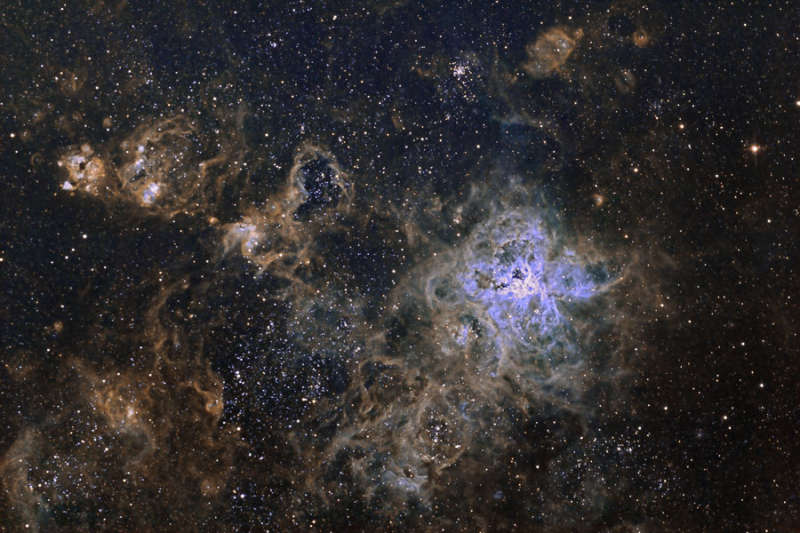
|
Credit & Copyright: Marcelo Salemme
Explanation:
It is the largest and most complex star forming region in the entire galactic neighborhood.
Located in the
Large Magellanic Cloud, a small satellite galaxy orbiting
our Milky Way galaxy,
the region's
spidery appearance is responsible for its popular name, the Tarantula
nebula.
This tarantula, however, is about 1,000
light-years across.
Were it placed at the distance of Milky Way's
Orion Nebula,
only 1,500 light-years distant and the nearest stellar nursery to Earth, it
would appear to cover about 30 degrees
(60 full moons) on the sky.
Intriguing details of the nebula are visible in
the above image shown in
scientific colors.
The spindly arms of the
Tarantula nebula
surround
NGC 2070, a
star cluster that contains some of the brightest,
most massive stars known,
visible in blue on the right.
Since massive stars
live fast and die young,
it is not so surprising that
the cosmic Tarantula
also lies near the site of the closest
recent supernova.
|
January February March April May June July August September October November December |
| |||||||||||||||||||||||||||||||||||||||||||||||||||||||
NASA Web Site Statements, Warnings, and Disclaimers
NASA Official: Jay Norris. Specific rights apply.
A service of: LHEA at NASA / GSFC
& Michigan Tech. U.
Based on Astronomy Picture
Of the Day
Publications with keywords: Large Magellanic Cloud - LMC - Tarantula Nebula - star formation
Publications with words: Large Magellanic Cloud - LMC - Tarantula Nebula - star formation
See also:
- APOD: 2025 July 10 Á Lynds Dark Nebula 1251
- APOD: 2025 June 23 Á W5: Pillars of Star Formation
- APOD: 2025 April 28 Á Gum 37 and the Southern Tadpoles
- APOD: 2025 March 26 Á Star Formation in the Pacman Nebula
- APOD: 2024 October 22 Á M16: Pillars of Star Creation
- APOD: 2024 October 2 Á The Large Magellanic Cloud Galaxy
- Star Factory Messier 17
